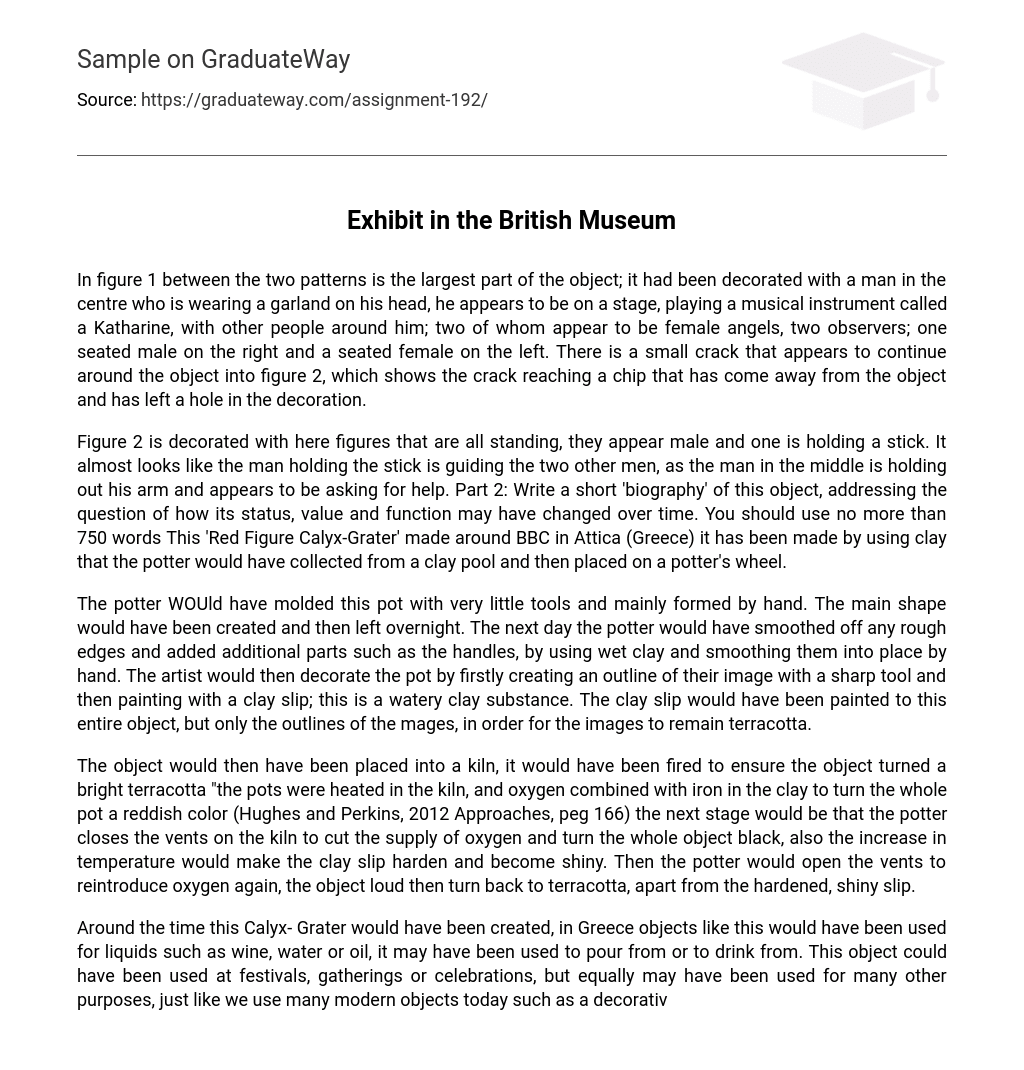In figure 1 between the two patterns is the largest part of the object; it had been decorated with a man in the centre who is wearing a garland on his head, he appears to be on a stage, playing a musical instrument called a Katharine, with other people around him; two of whom appear to be female angels, two observers; one seated male on the right and a seated female on the left. There is a small crack that appears to continue around the object into figure 2, which shows the crack reaching a chip that has come away from the object and has left a hole in the decoration.
Figure 2 is decorated with here figures that are all standing, they appear male and one is holding a stick. It almost looks like the man holding the stick is guiding the two other men, as the man in the middle is holding out his arm and appears to be asking for help. Part 2: Write a short ‘biography’ of this object, addressing the question of how its status, value and function may have changed over time. You should use no more than 750 words This ‘Red Figure Calyx-Grater’ made around BBC in Attica (Greece) it has been made by using clay that the potter would have collected from a clay pool and then placed on a potter’s wheel.
The potter WOUld have molded this pot with very little tools and mainly formed by hand. The main shape would have been created and then left overnight. The next day the potter would have smoothed off any rough edges and added additional parts such as the handles, by using wet clay and smoothing them into place by hand. The artist would then decorate the pot by firstly creating an outline of their image with a sharp tool and then painting with a clay slip; this is a watery clay substance. The clay slip would have been painted to this entire object, but only the outlines of the mages, in order for the images to remain terracotta.
The object would then have been placed into a kiln, it would have been fired to ensure the object turned a bright terracotta “the pots were heated in the kiln, and oxygen combined with iron in the clay to turn the whole pot a reddish color (Hughes and Perkins, 2012 Approaches, peg 166) the next stage would be that the potter closes the vents on the kiln to cut the supply of oxygen and turn the whole object black, also the increase in temperature would make the clay slip harden and become shiny. Then the potter would open the vents to reintroduce oxygen again, the object loud then turn back to terracotta, apart from the hardened, shiny slip.
Around the time this Calyx- Grater would have been created, in Greece objects like this would have been used for liquids such as wine, water or oil, it may have been used to pour from or to drink from. This object could have been used at festivals, gatherings or celebrations, but equally may have been used for many other purposes, just like we use many modern objects today such as a decorative vase today, may be used for flowers, but could also be used as an ornament. This vase would have had little value when being used as a practical object, but wrought time, objects of this kind would have depreciated and then become desired.
Although in modern day this object is seen as rare, beautiful and worth large sums of money. In the days in which this object was used for its intended purpose, it may have actually been a low cost item. “… Large-scale examples would have been reasonably low-cost. ” (Hughes and Perkins, 2012 Approaches, peg 171) The owner of this object ‘Sir William Hamilton’ sold the vase to the British Museum in 1772. He acquired the vase whilst living in Italy and believed that Homers poetry was the beginning to transform art. E believed that the sublime quality of Homer’s poetry had transformed the visual arts from their primitive origins to the beautiful naturalism displayed here. ‘ (British Museum, red-figured calyx-grater) He hoped that by selling the piece to the British Museum, it would inspire future art. It wasn’t until the eighteenth century that this ‘Red Figure Calyx-Grater’ was identified as being the ‘Apotheosis of homer’ which is said to have been the poet Homer becoming a god, but is regarded as fanciful and in recent modern times, it has been seen that the images portray a contest or show.
Downheartedness’s interpretation of the subject as the Apotheosis of Homer must now be regarded as fanciful. ‘ (British Museum, red-figured calyx-grater) After many years of the Red Figure Calyx-Crater’s creation, in the afterlife of its purposed use, it became inspiration for artist John Flagman Junior, who used this Greek vase to create his own interpretation of his works ‘The Pegasus Vase’ in 1786. It is a Westwood piece that incorporates the scene from the Greek vase. ‘the figures in the main scene are based on an engraving of a Greek vase of the fourth century BC, the figures in the main scene are based on an engraving of a
Greek vase of the fourth century BC. ‘ (British Museum, The Pegasus Vase) This was the intended purpose for Sir William Hamiltonians sale of the object to the British Museum. He had hoped that many future British artists would be inspired by the vase and its scenes. ‘Hamilton hoped that his collection would improve the work of artists and artisans in Britain’ (British Museum, red-figured calyx-grater) This object has had a long journey through the years, firstly being made for an intended purpose and used in many ways in BBC, then it was acquired by ‘Sir William Hamilton’ in Italy and was appreciated for its beauty and art.





